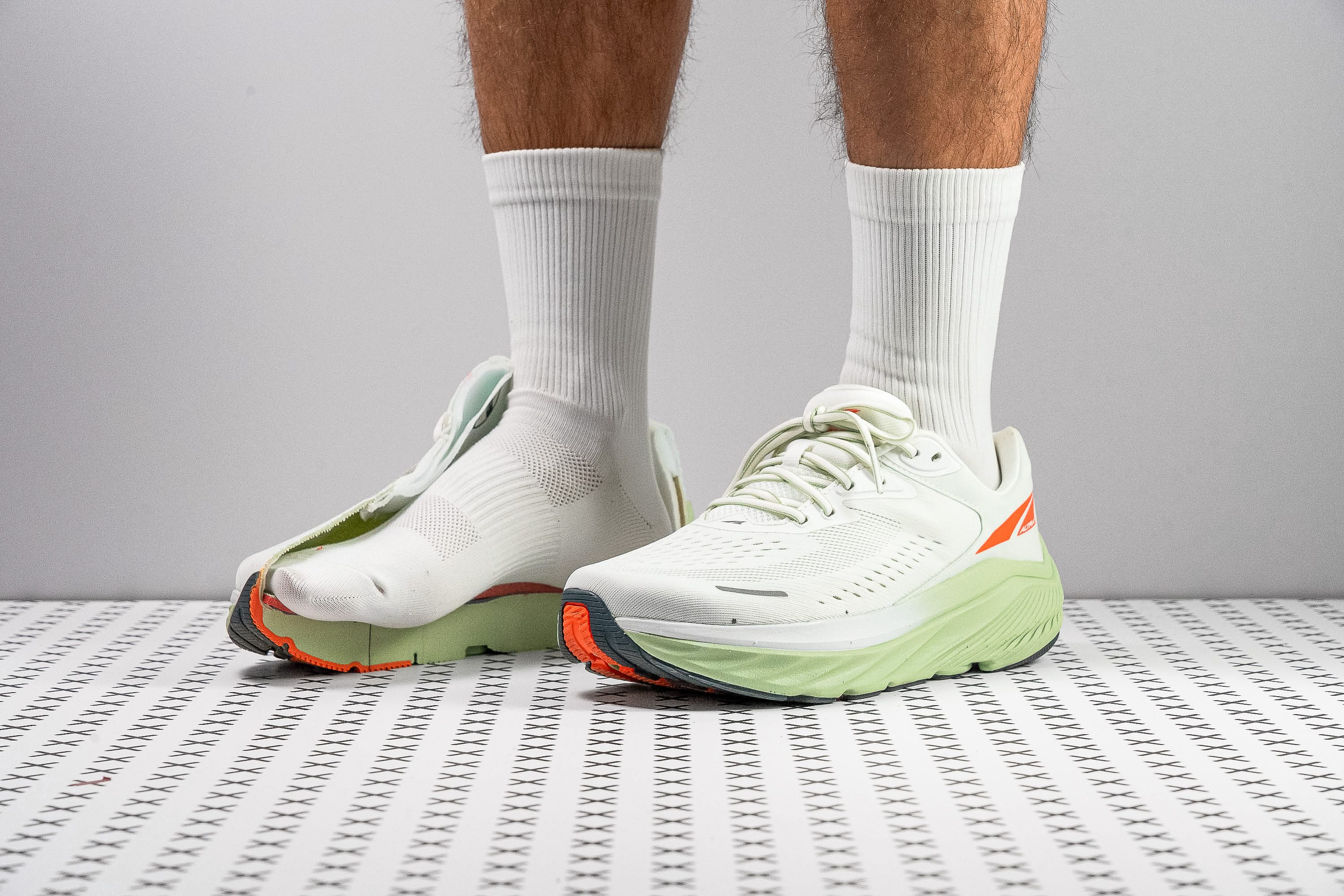Our verdict
- Top pick in best zero drop running shoes
- Top pick in best Altra running shoes
Pros
- Incredibly roomy toebox
- Authentic zero-drop design
- Extremely cushy and soft midsole
- Superb all-around durability
- Cozy upper
- Remarkably stable
- Ideal for long runs
Cons
- Limited ventilation
- Tongue not gusseted
- Still a bit heavy
Audience verdict
Comparison
The most similar running shoes compared
+ + Add a shoe | |||||
|---|---|---|---|---|---|
| Audience score | 85 Good! | 84 Good! | 85 Good! | 87 Great! | |
| Price | $165 | $140 | $130 | $150 | |
| Pace | Daily running | Daily running | Daily runningTempo | Daily running | |
| Shock absorption | - | - | - | Low | |
| Energy return | - | - | - | Moderate | |
| Traction | - | - | - | High | |
| Arch support | Neutral | Stability | Neutral | Neutral | |
| Weight lab Weight brand | 10.4 oz / 295g 10.5 oz / 297g | 9.6 oz / 273g 10.2 oz / 289g | 8.3 oz / 235g 10 oz / 283g | 9.7 oz / 275g 10.1 oz / 287g | |
| Lightweight | ✗ | ✗ | ✓ | ✗ | |
| Drop lab Drop brand | -0.2 mm 0.0 mm | 0.2 mm 0.0 mm | 0.4 mm 0.0 mm | -0.1 mm 0.0 mm | |
| Strike pattern | Mid/forefoot | Mid/forefoot | Mid/forefoot | Mid/forefoot | |
| Size | True to size | True to size | Slightly small | True to size | |
| Midsole softness | Soft | Balanced | Soft | Balanced | |
| Difference in midsole softness in cold | Small | Normal | Normal | Normal | |
| Toebox durability | Good | Decent | Decent | Good | |
| Heel padding durability | Good | Decent | Bad | Good | |
| Outsole durability | Good | Good | Good | Good | |
| Breathability | Warm | Moderate | Moderate | Moderate | |
| Width / fit | Wide | Medium | Narrow | Medium | |
| Toebox width | Wide | Wide | Wide | Wide | |
| Stiffness | Stiff | Stiff | Stiff | Moderate | |
| Torsional rigidity | Stiff | Moderate | Flexible | Moderate | |
| Heel counter stiffness | Moderate | Flexible | Flexible | Stiff | |
| Heel lab Heel brand | 34.8 mm 33.0 mm | 26.0 mm 28.0 mm | 28.4 mm 28.0 mm | 27.6 mm 30.0 mm | |
| Forefoot lab Forefoot brand | 35.0 mm 33.0 mm | 25.8 mm 28.0 mm | 28.0 mm 28.0 mm | 27.7 mm 30.0 mm | |
| Widths available | Normal | Normal | Normal | NormalWide | |
| Orthotic friendly | ✓ | ✓ | ✓ | ✓ | |
| Season | All seasons | All seasons | All seasons | All seasons | |
| Removable insole | ✓ | ✓ | ✓ | ✓ | |
| Ranking | #226 Bottom 39% | #251 Bottom 33% | #211 Bottom 43% | #169 Top 46% | |
| Popularity | #131 Top 35% | #245 Bottom 34% | #287 Bottom 23% | #70 Top 19% |
Who should buy
We're convinced that the Altra VIA Olympus 2 is a top pick for:
- Altra enthusiasts seeking the ultimate marathon training shoe, offering unparalleled comfort.
- Those curious about zero-drop footwear but unwilling to sacrifice cushioning.
- Individuals with wide feet desiring a shoe that perfectly accommodates their broad foot shape, thanks to its exceptionally spacious design.
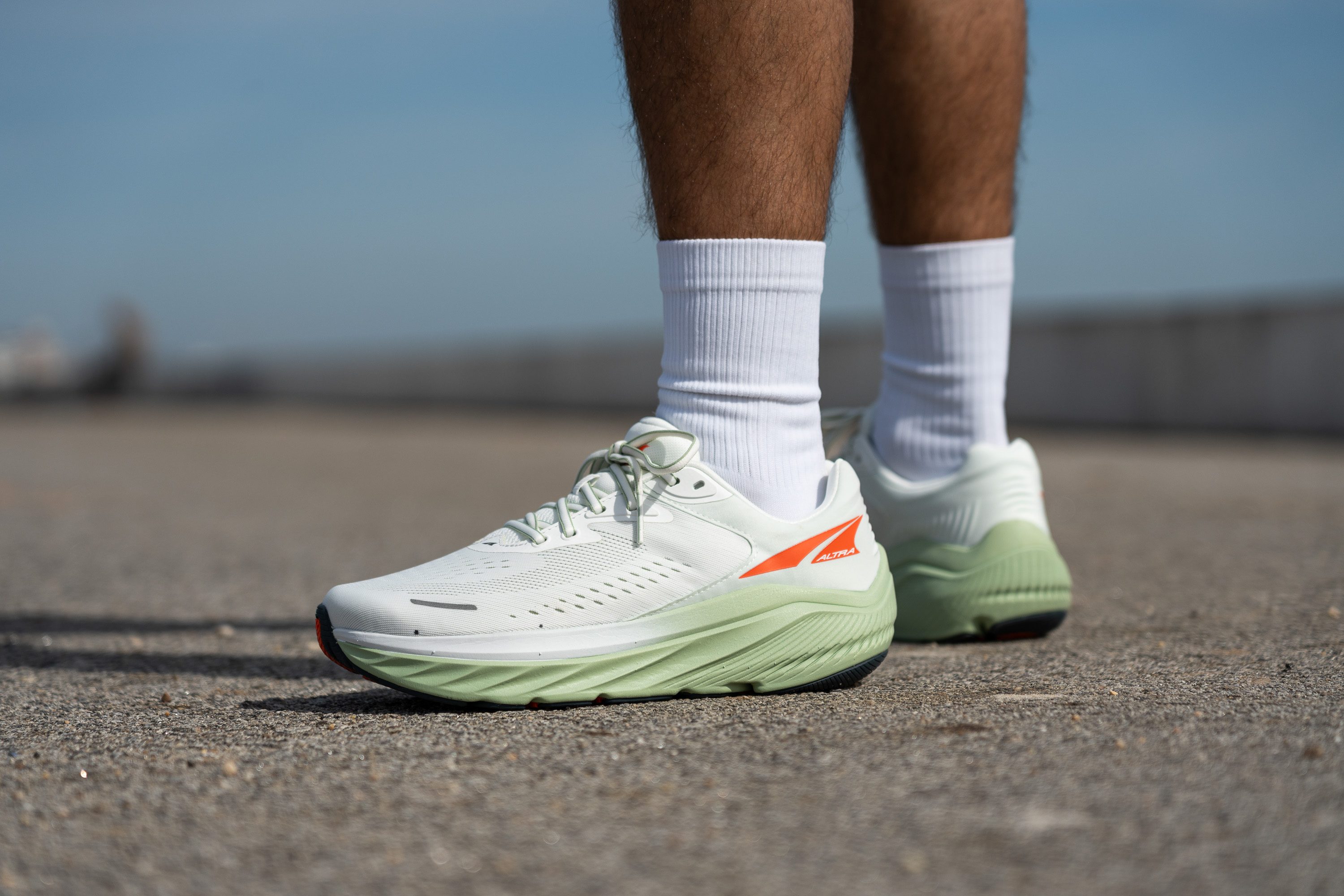
Who should NOT buy
While the VIA Olympus 2 boasts many strengths, we caution against making a sudden switch if you're accustomed to 8-to-10-mm offsets. For a smoother transition with ample cushioning, we suggest starting with a mid-drop shoe like the Hoka Clifton 9 before fully committing to a zero-drop option.
Furthermore, we advise against choosing the VIA Olympus 2 for those who prioritize a lightweight and flexible shoe. Instead, the Altra Torin 7, with its featherlight build and the same zero-drop design, offers less stiffness and more agility.
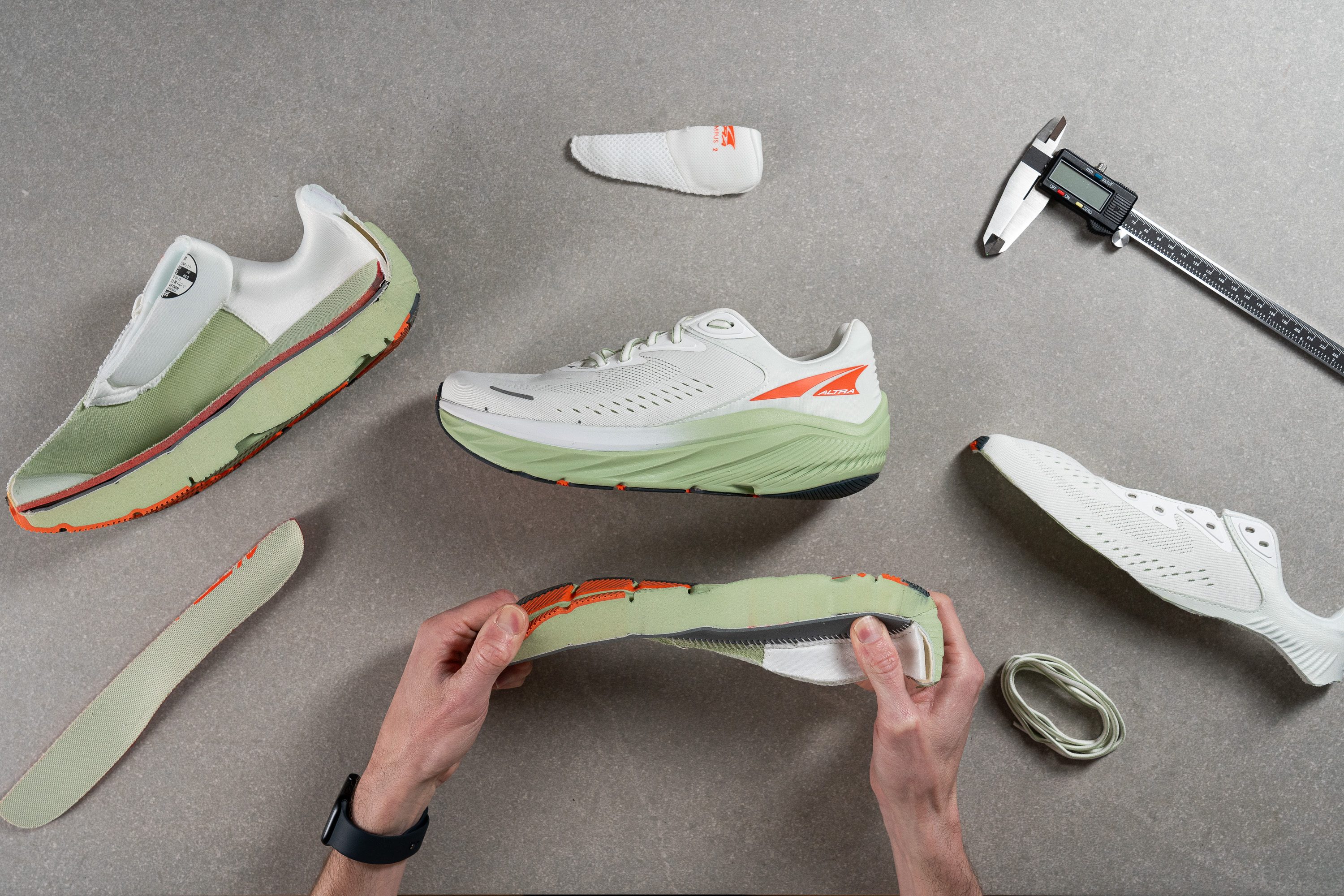
Cushioning
Heel stack
After measuring with our calipers, we recorded a generous 34.8 mm stack height in the heel, confirming this Altra's maximalist nature.
This ample cushioning makes it an ideal choice for heel strikers and those gearing up for long runs in a marathon prep.
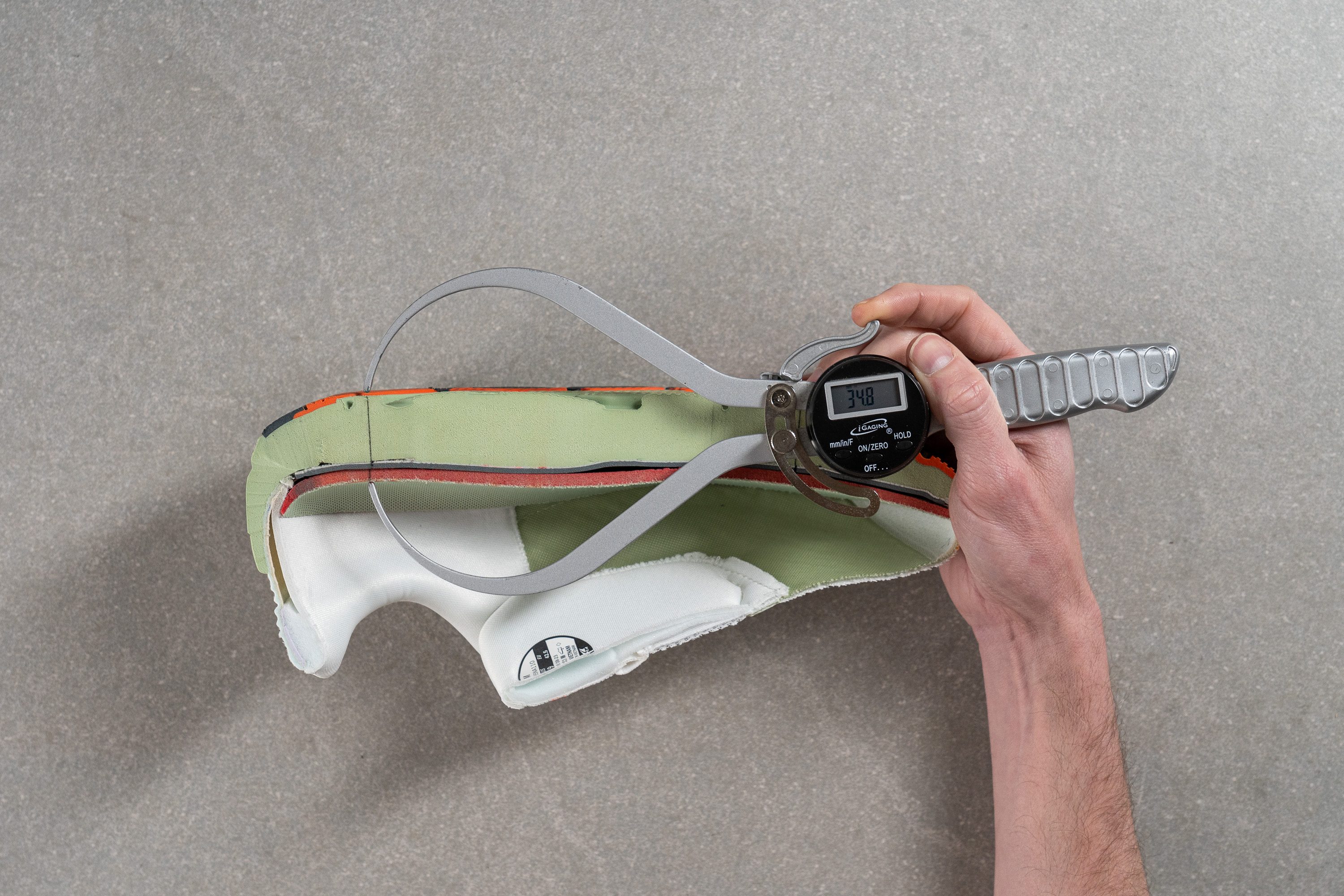
| VIA Olympus 2 | 34.8 mm |
| Average | 34.8 mm |
Forefoot stack
Shifting our focus to the forefoot, our calipers revealed a towering 35.0 mm of cushioning, ranking this Altra among the most generously padded shoes we've encountered in this region.
For forefoot strikers craving the ultimate cushioning in a low-drop shoe, we found that the VIA Olympus 2 stands out as a prime choice. That's a thick slab of foam!
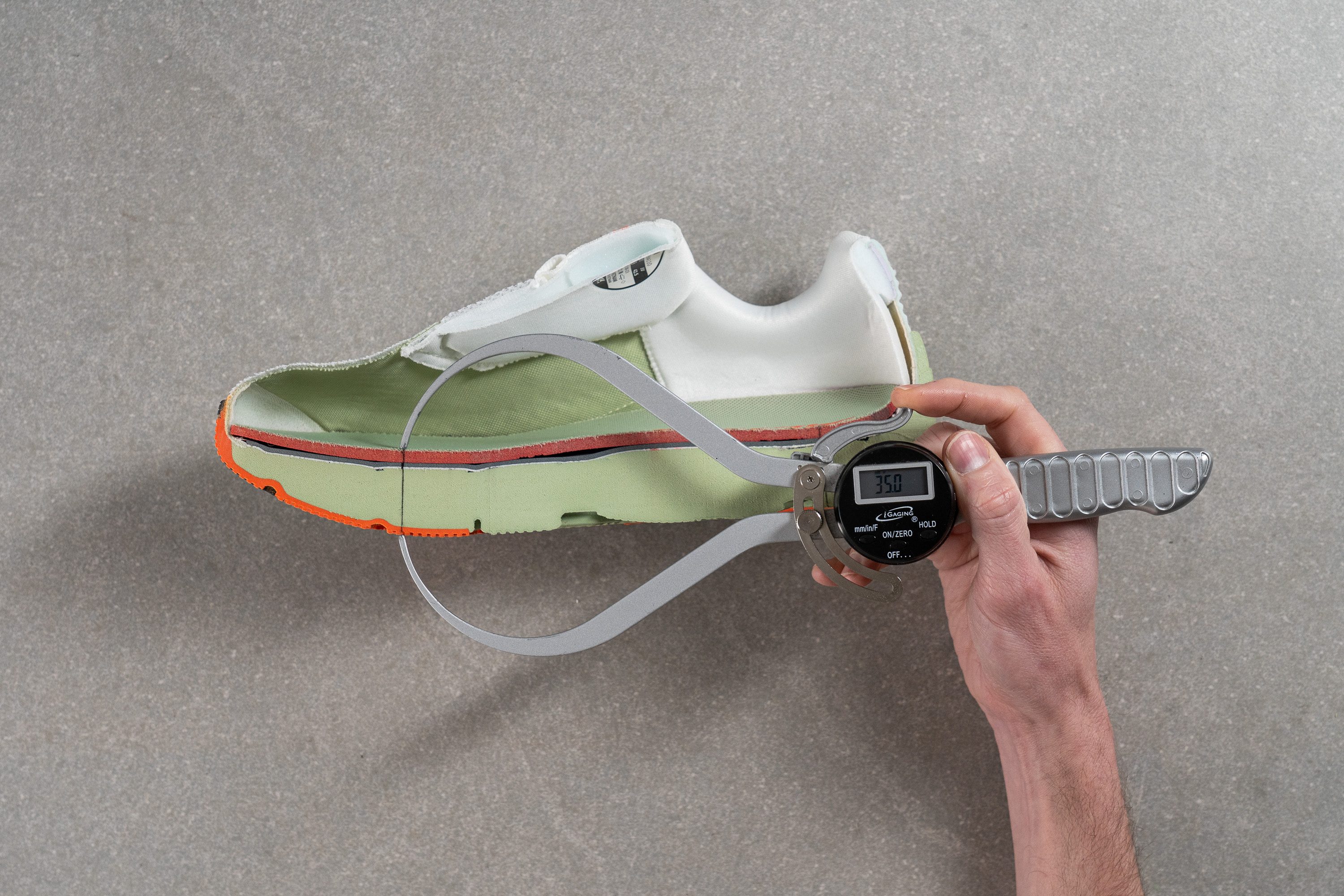
| VIA Olympus 2 | 35.0 mm |
| Average | 26.2 mm |
Drop
Altra reigns as the absolute leader of zero-drop running shoes, and the VIA Olympus 2 lives up to this reputation.
Our precise measurements confirmed a virtually non-existent drop of -0.2 mm, solidifying its status as a true zero-drop shoe.

| VIA Olympus 2 | -0.2 mm |
| Average | 8.6 mm |
Midsole softness
Here's the biggest upgrade in the VIA Olympus 2 compared to its predecessor. The original's midsole, clocking in at 25.6 HA, gave a firmer ride. However, this latest iteration astounded us with a 14.5 HA score, translating to a 43% increase in softness.
This transformation is not just on paper; it's palpable with every stride, offering a zero-drop ride that's both plush and lively.
Altra's EGO MAX foam—a blend of EVA and TPU—fuels the midsole, enhancing both energy return and bounce. This new formulation keeps the name, but leaves behind the previous firmness, steering towards a more cushy underfoot feel.
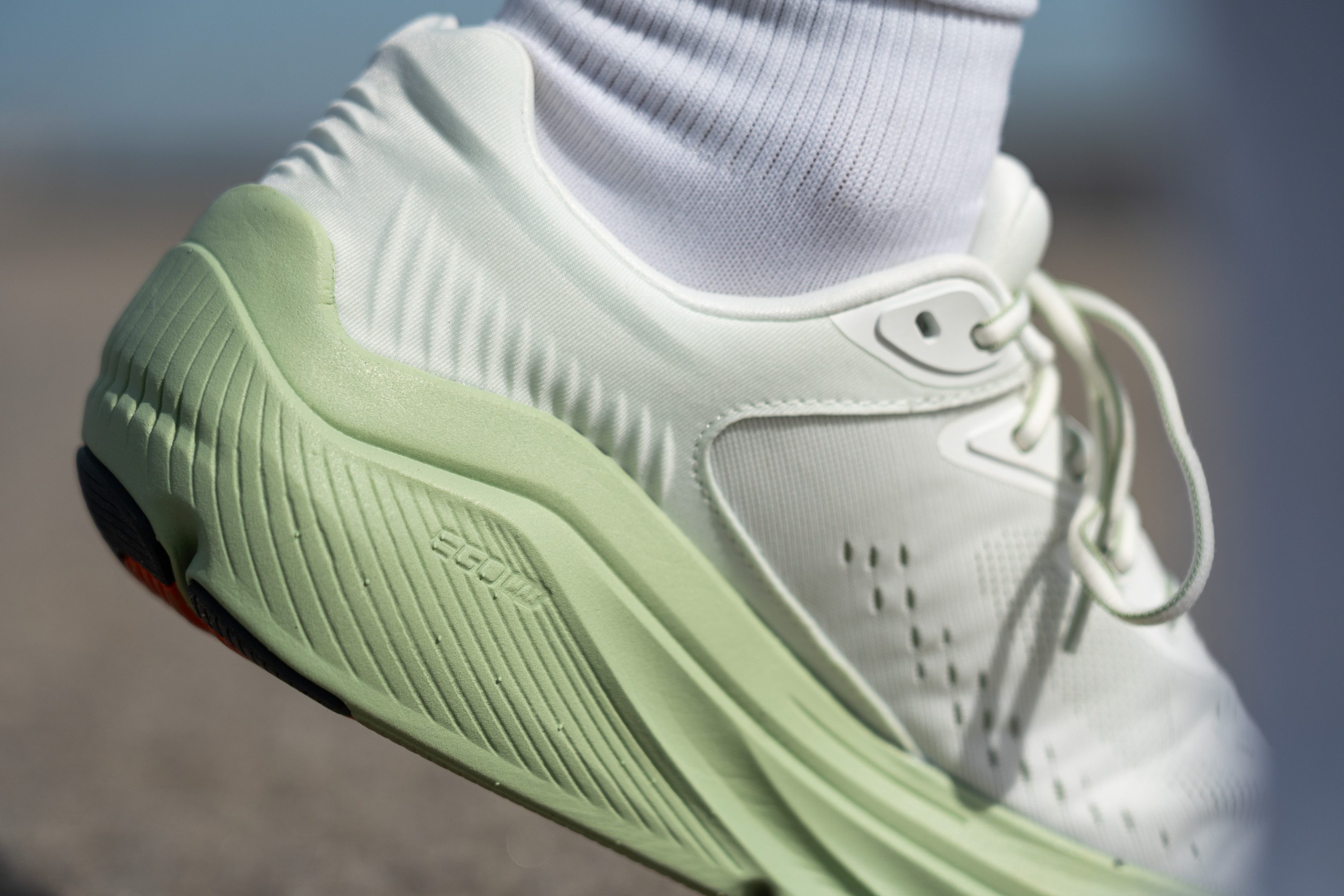
And we're all for this shift here in the lab, though we acknowledge it boils down to individual preference—if you prefer firmer midsoles, you'll be better with the v1.

| VIA Olympus 2 | 14.5 HA |
| Average | 20.4 HA |
Size and fit
Size
Altra VIA Olympus 2 fits true to size (37 votes).
Width / Fit
Measuring an impressive 100.3 mm in the widest part, the VIA Olympus 2 offers mind-boggling spaciousness and is an excellent choice for wide-footed runners seeking unparalleled comfort.
On the other hand, runners with narrow feet should avoid this model, as its ultra-generous fit leaves no way to make it work, not even by sizing down. We recommend checking the ASICS Gel Nimbus 26 instead.
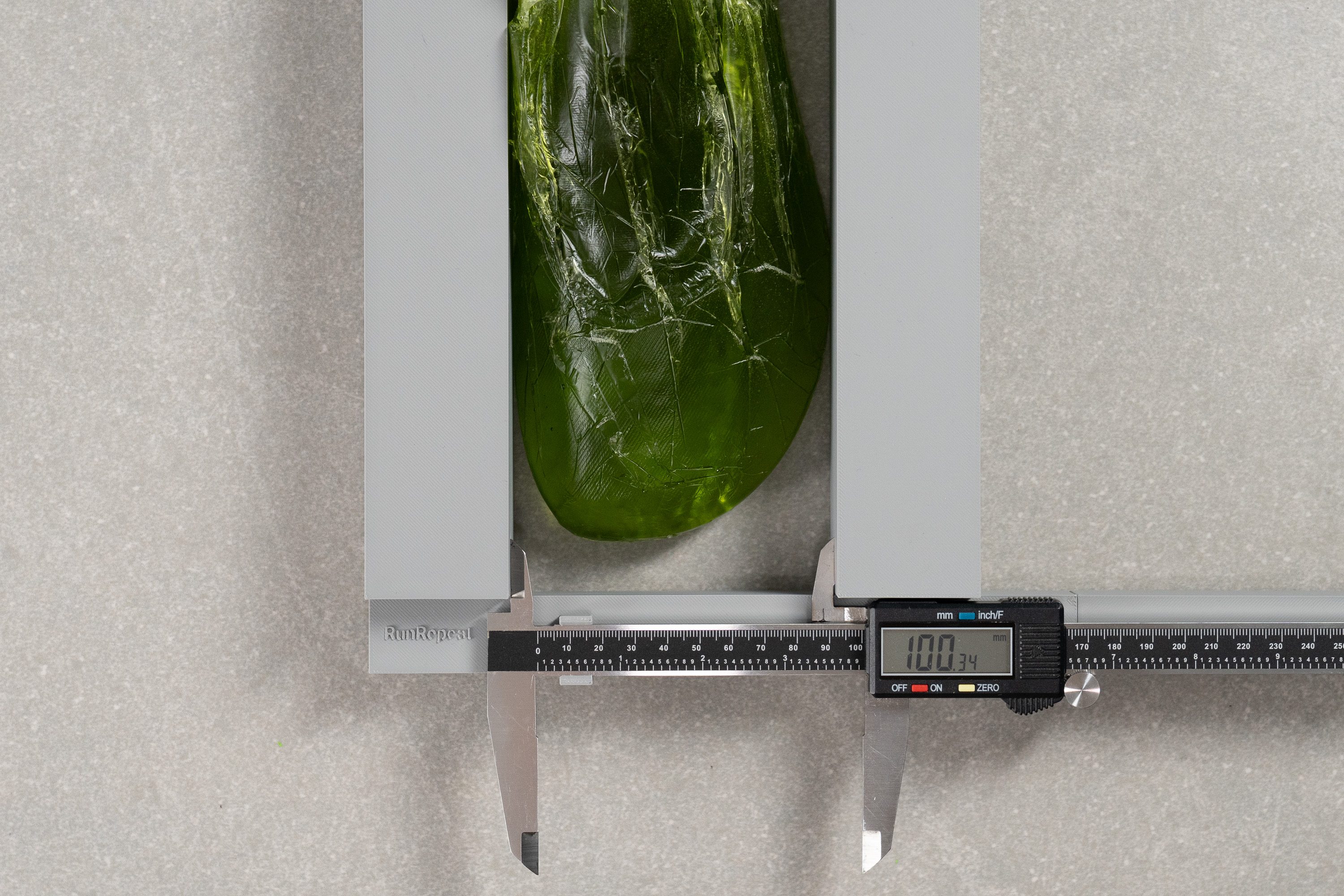
| VIA Olympus 2 | 100.3 mm |
| Average | 95.1 mm |
Toebox width
In our meticulous lab process, we consistently measure at two critical points in terms of width—the broadest part of the upper and the big toe area.
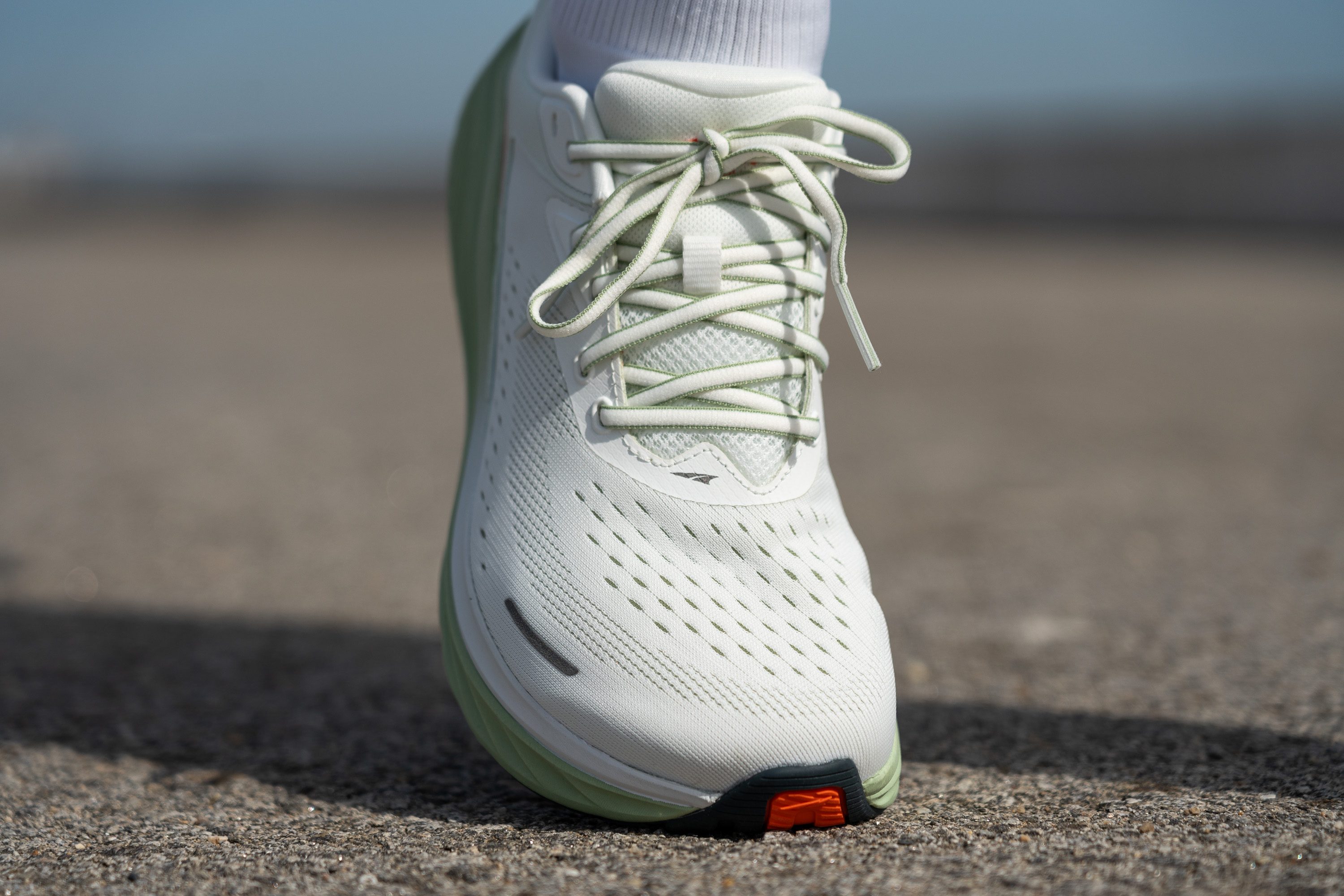
The Altra FootShape feature truly excels in this regard, boasting an impressive width of 81.7 mm. This ensures abundant room for toe splay, accommodating those with wider feet without exception.
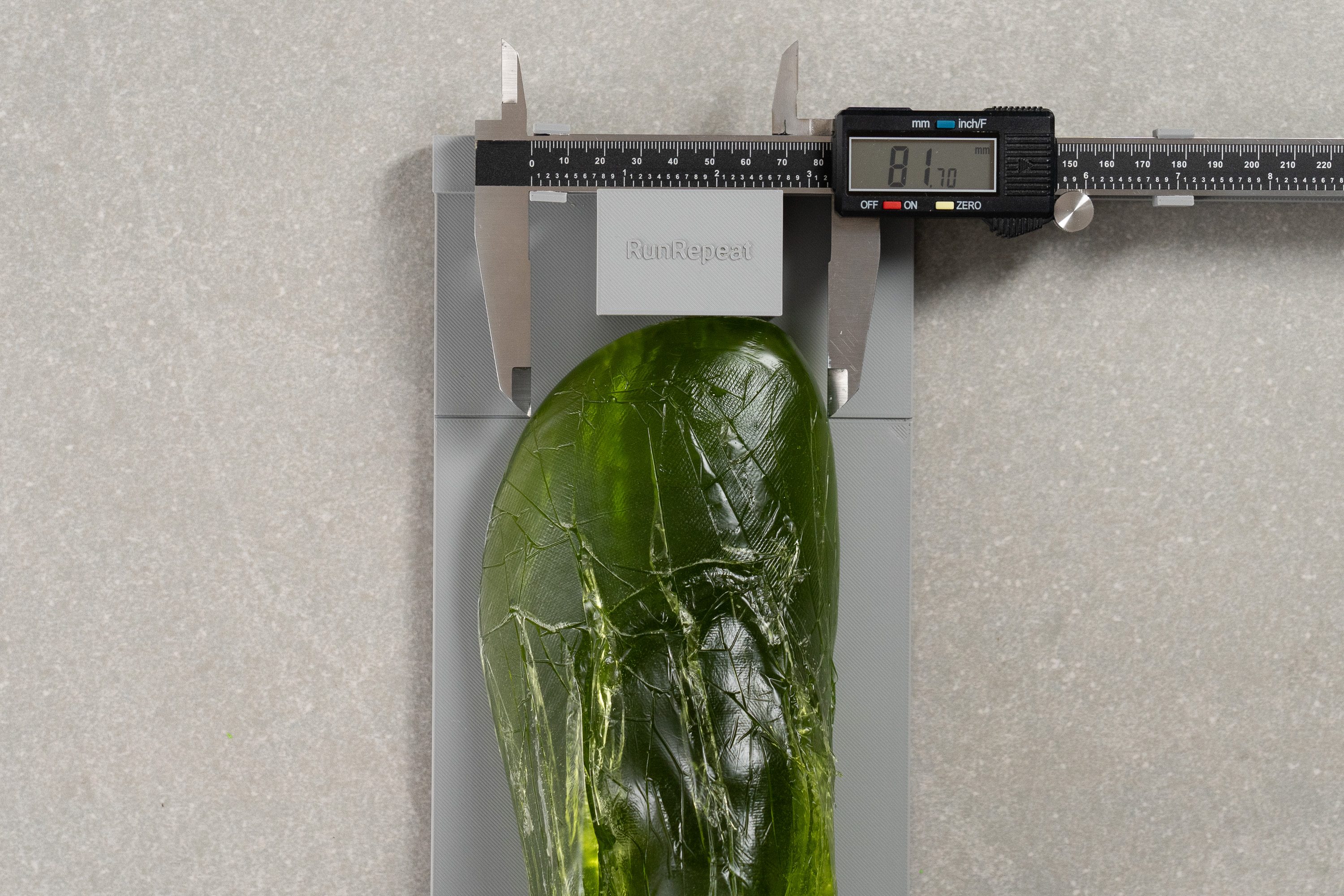
| VIA Olympus 2 | 81.7 mm |
| Average | 73.2 mm |
Toebox height
To wrap up our fit measurements, we recorded an impressive 30.4 mm of height. This confirms that the VIA Olympus 2 offers exceptional vertical space, ideal for runners who naturally point their toes upward while running.
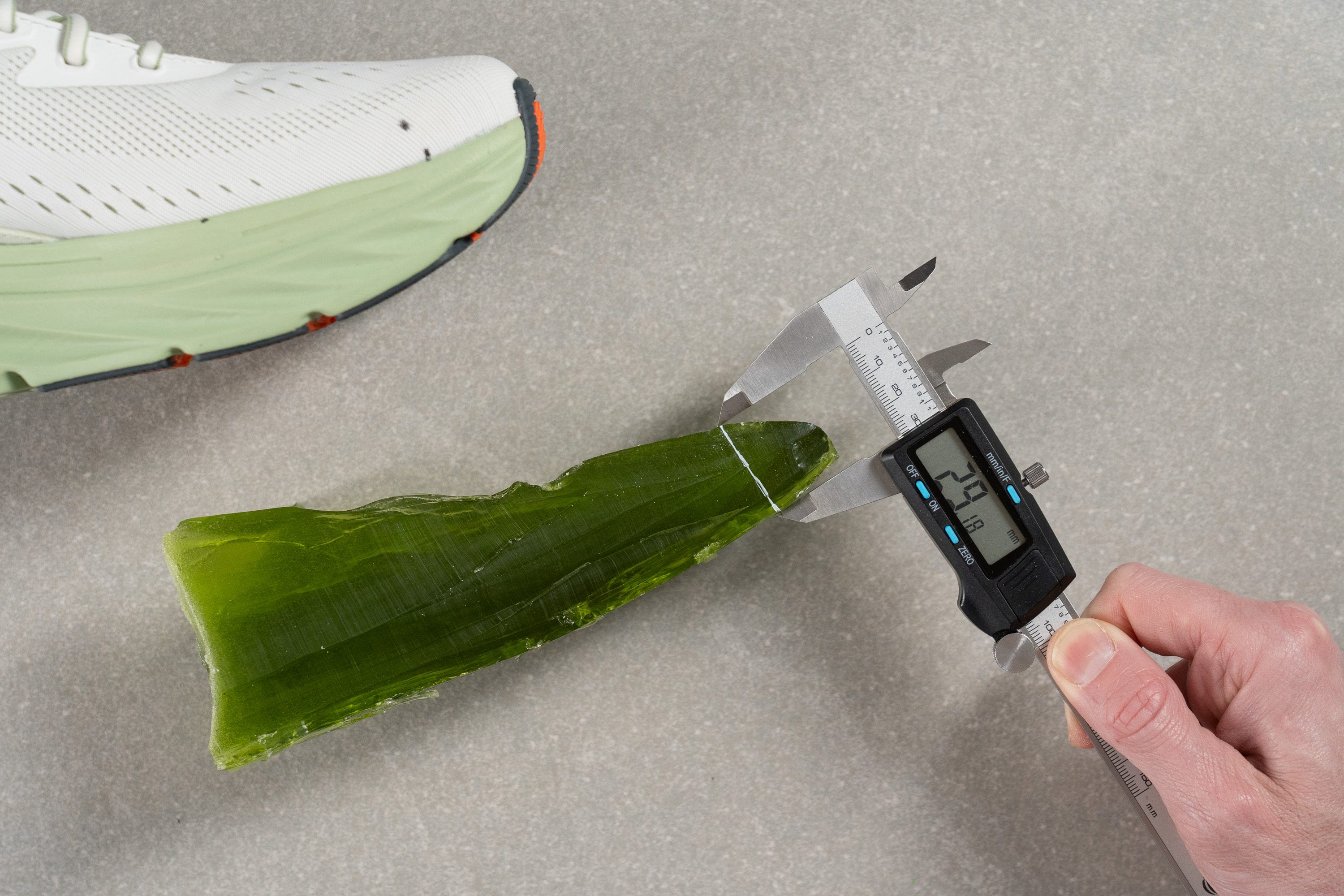
| VIA Olympus 2 | 29.2 mm |
| Average | 27.1 mm |
Flexibility / Stiffness
In a previous test, we highlighted the VIA Olympus 2's rigid build, yet its true test of longitudinal stiffness awaited our rigorous 90-degree challenge.
Conducting four precise measurements with our force gauge, we averaged 41.3N, surprisingly high for a non-plated shoe. This level of stiffness is reminiscent of some plated counterparts.
This test follows an older methodology, which is why you don't see recently tested shoes in the chart. Results from different methodologies can not be compared.
| VIA Olympus 2 | 41.3N |
| Average | 28.1N |
Stiffness in cold (%)
We subjected the EGO MAX foam to another round of stiffness testing under cold conditions and discovered a barely noticeable change—only a 12.1% increase in stiffness. This result is definitely great.
| VIA Olympus 2 | 12% |
| Average | 33% |
Weight
Given its maximalist design, the VIA Olympus 2 isn't aiming for featherlight status—though we've seen ultra-high-stack models like the ASICS Superblast defy expectations.
Tipping our scales at 10.4 oz or 295g, this edition mirrors its predecessor's heft. While not overly heavy for its class, we really think that Altra could improve this model to dip below the 10-ounce mark.

| VIA Olympus 2 | 10.4 oz (295g) |
| Average | 9.3 oz (264g) |
Breathability
Upon examining the VIA Olympus 2, our initial focus was on breathability.
Employing our eye-catching smoke test in the lab, we quickly realized that the shoe's ventilation didn't live up to our hopes, meriting a score of just 2 out of 5. This positions it as more suitable for the colder months.
Despite observing numerous ventilation holes in the toebox and medial side through a light test, the actual airflow was minimal.
Intrigued by this discrepancy, we utilized a microscope to delve deeper.

We discovered that Altra employed a dual-layer structure, combining an external engineered mesh with an internal layer of soft, green fabric. This choice, while enhancing comfort, unfortunately compromises breathability.
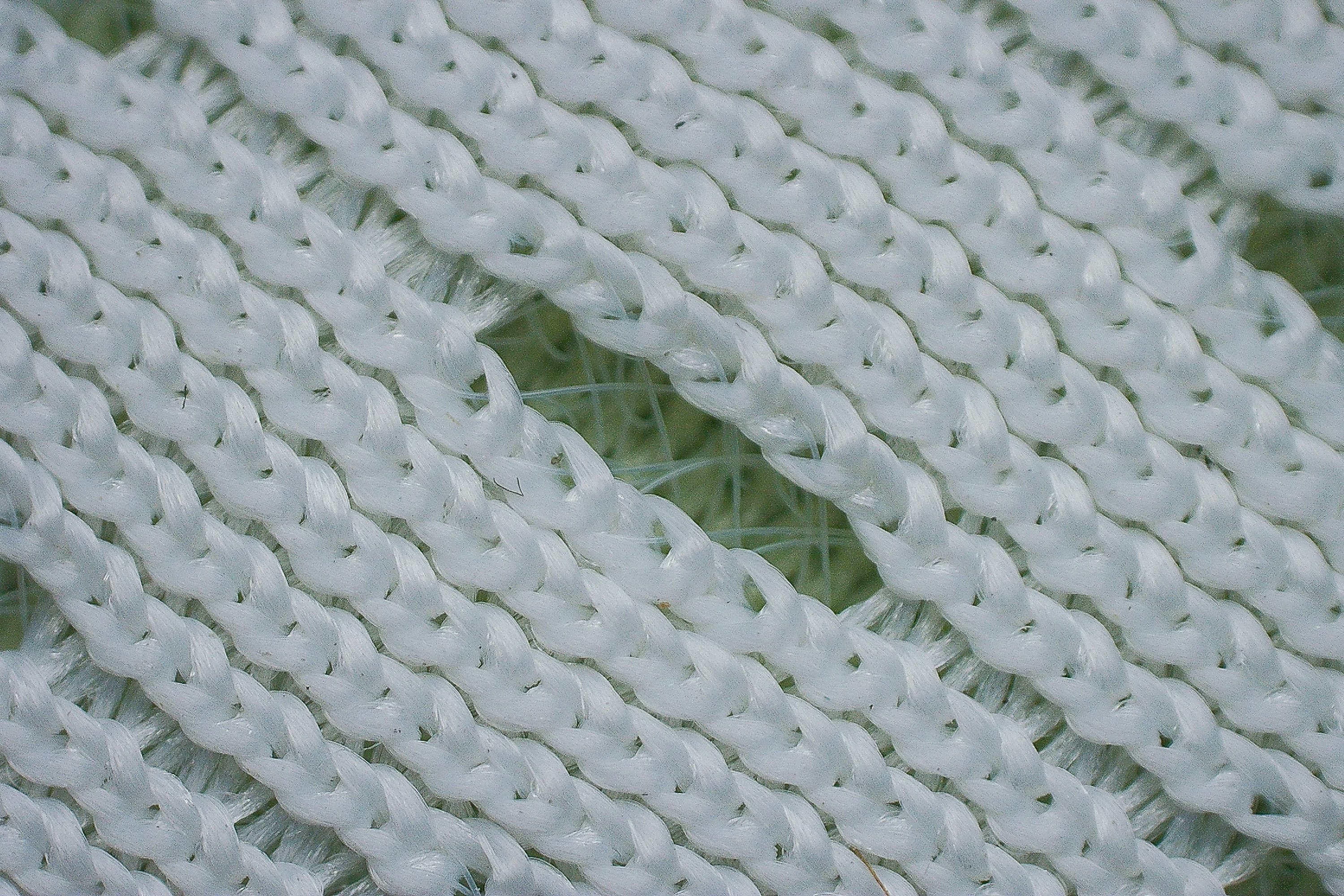
The shoe's upper is notably plush and comfortable, yet this comes with a notable reduction in ventilation.
While we wouldn't recommend this model for scorching summer days, its cozy construction offers enough breathability the rest of the year, especially when paired with super-thin socks.
| VIA Olympus 2 | 2 |
| Average | 3.7 |
Stability
Lateral stability test
While officially a neutral running shoe, our testing reveals it could also cater to those with slight stability needs. Packed with stability features and leveraging the natural support of its zero-drop design, it promises a supremely stable ride for forefoot or midfoot strikers.
Conversely, heel strikers seeking additional support, particularly those lacking adequate dorsiflexion, might lean towards a more supportive, higher-drop shoe like the Hoka Gaviota 5.
Torsional rigidity
Maximalist shoes like the VIA Olympus 2 often feature high torsional rigidity due to the substantial foam underfoot—a notion we quickly felt during our initial runs.
Subsequently, our hands-on evaluation solidified this impression, earning the shoe a 4 out of 5 in rigidity. Hence, it's clear that agility might not be its strongest suit.
| VIA Olympus 2 | 4 |
| Average | 3.5 |
Heel counter stiffness
The heel counter strikes a balance, mirroring what you'd find in typical daily trainers. This is a deliberate choice that we like for a shoe aimed at providing enough heel support while also being capable of tackling 20-milers.
| VIA Olympus 2 | 3 |
| Average | 2.9 |
Midsole width - forefoot
Next up, we delved into the shoe's measurements, kicking off with the forefoot width.
We recorded it at a solid 115.2 mm—fairly standard, though the shoe presents a wider feel while running, likely attributed to its zero-drop geometry.
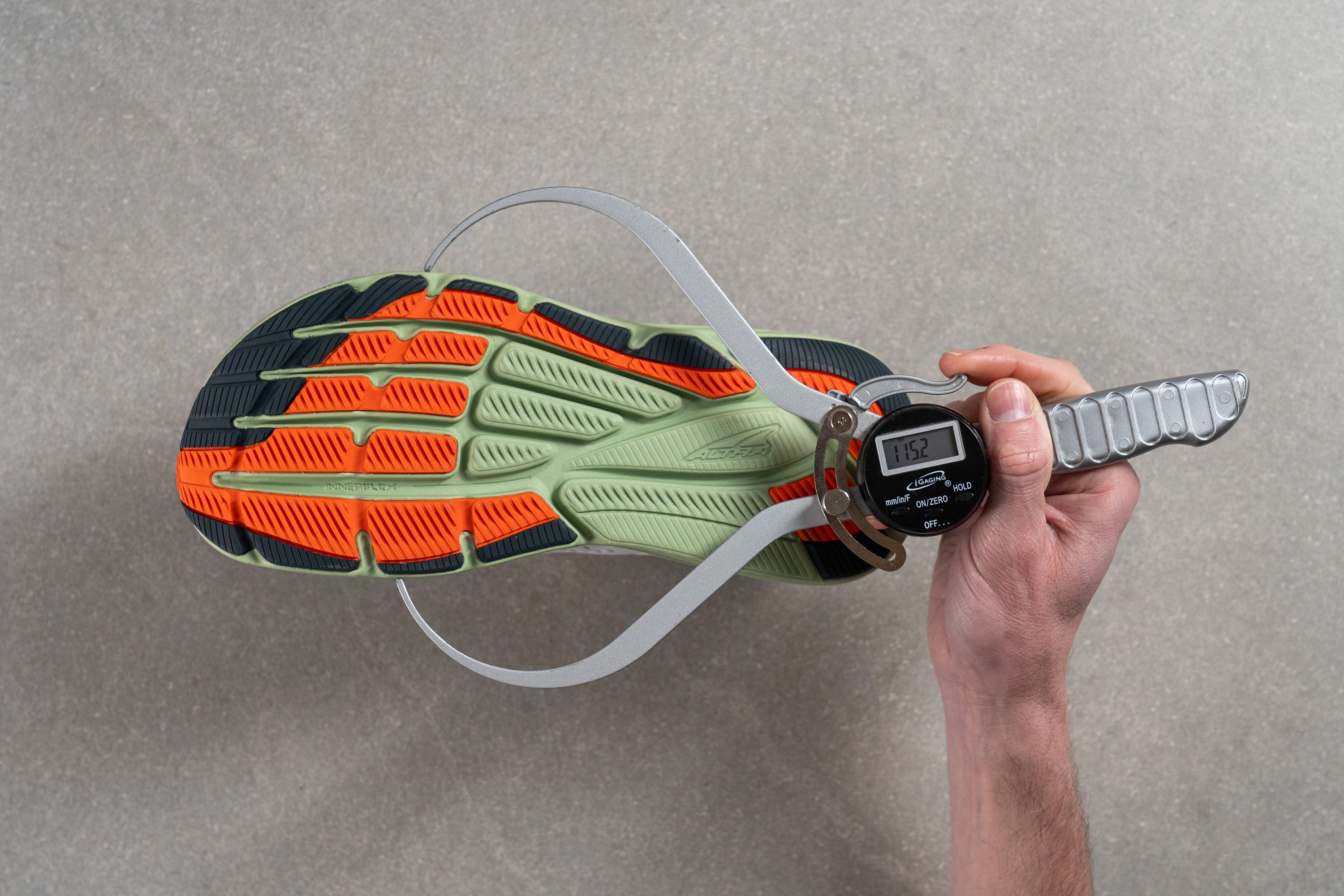
| VIA Olympus 2 | 115.2 mm |
| Average | 114.4 mm |
Midsole width - heel
True to Altra's signature design, both the midfoot and heel are generously wide.
Our precise measurement of 95.3 mm at the heel confirms it, offering rearfoot strikers a substantial platform for a secure and stable landing.
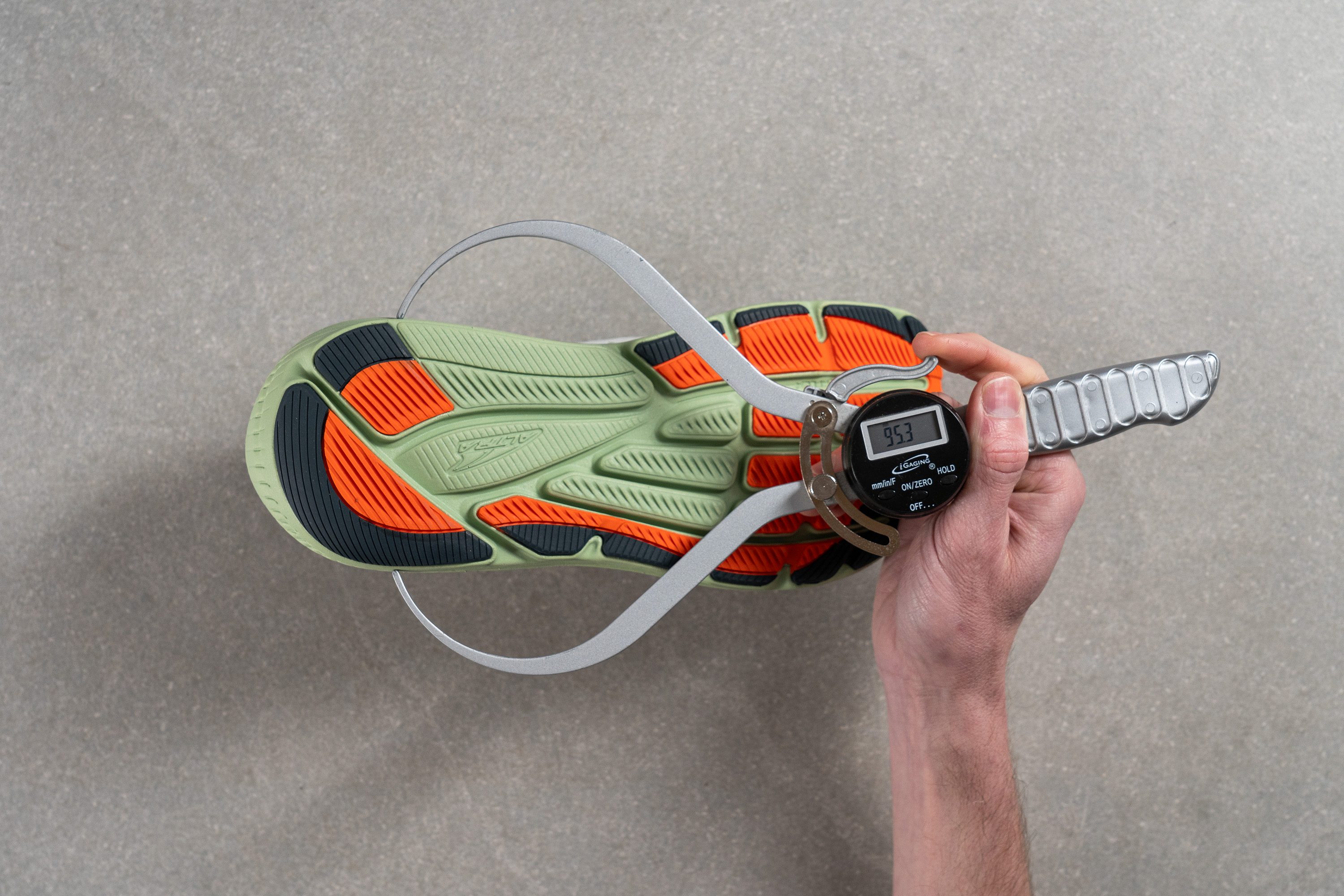
| VIA Olympus 2 | 95.3 mm |
| Average | 90.7 mm |
Durability
Toebox durability
One great perk of less breathable uppers is their tendency to excel in our durability test. Eager to see how the VIA Olympus 2 would hold up, we pitted it against our Dremel for an ultimate showdown.
And the winner is the VIA Olympus 2! Following such an impressive showing, we were thrilled to award it a perfect 5 out of 5. This mesh is built to last, making it an exceptional choice for road runners seeking a durable upper.
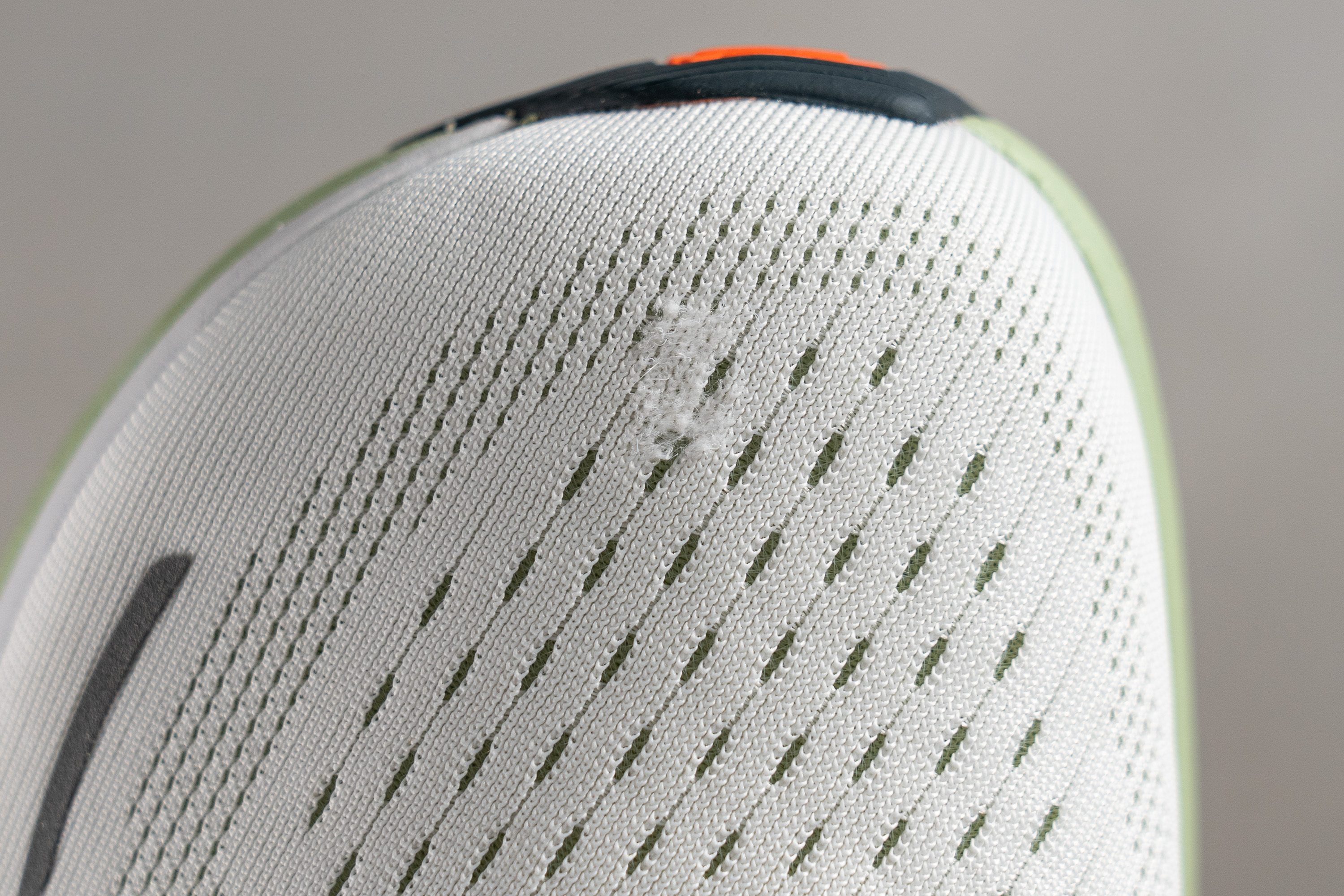
| VIA Olympus 2 | 5 |
| Average | 2.6 |
Heel padding durability
Following the outstanding initial test, our expectations were really high. Nonetheless, the heel padding didn't disappoint.
In our second Dremel assessment, we were greeted with another fantastic outcome. While it may not have reached the pinnacle of excellence, it stood out significantly when compared to the vast majority of running footwear. That's a 4/5 for us.
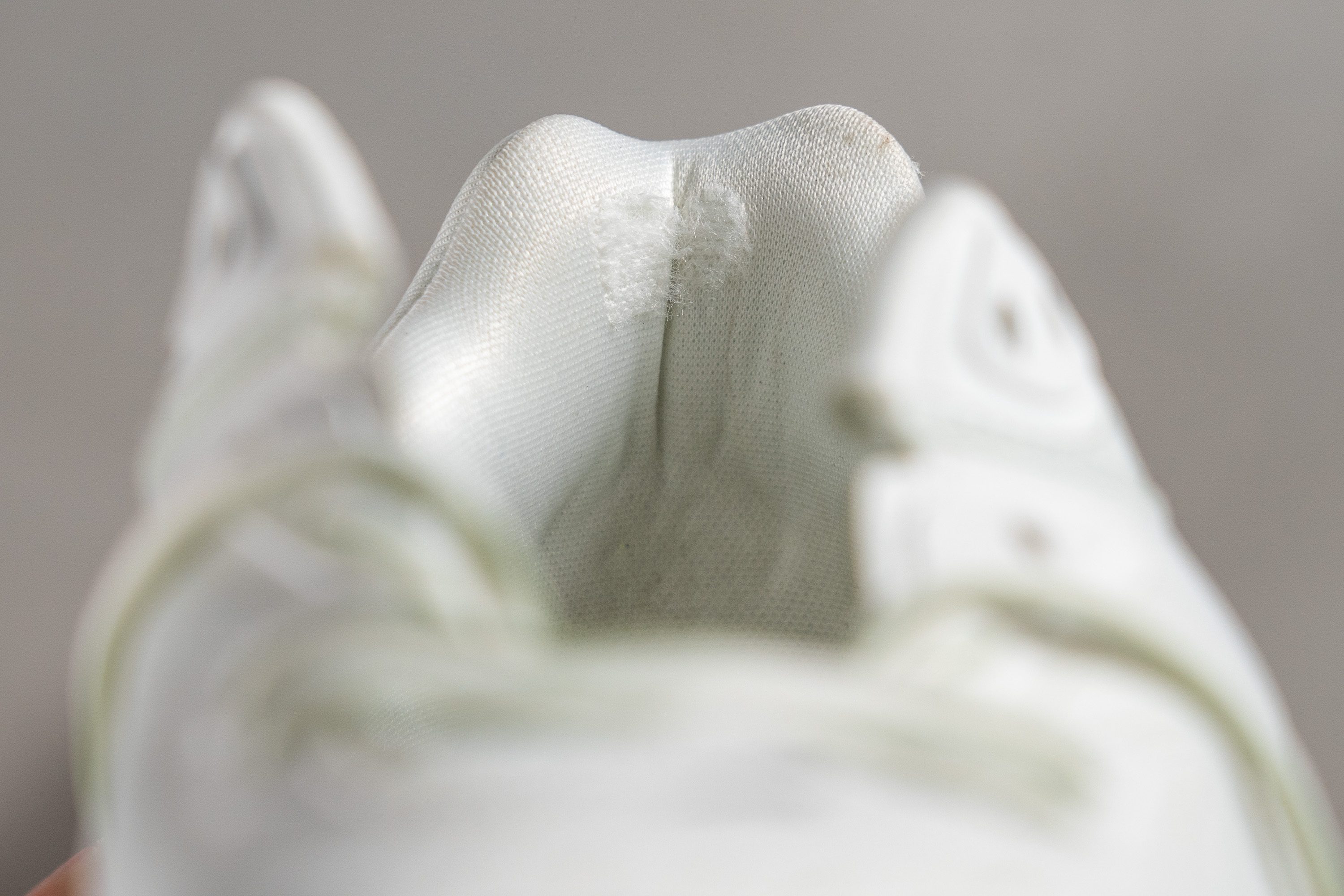
| VIA Olympus 2 | 4 |
| Average | 3.4 |
Outsole hardness
Next, we turned our attention to the outsole. With such a robust upper, it's crucial that the outsole matches in durability—after all, a durable mesh paired with a less resilient rubber just wouldn't make sense. You need the entire shoe to be tough!

Our initial examination focused on the outsole's hardness. To our surprise, we found it to be significantly softer than its predecessor at 73.3 HC, a 19% reduction in hardness. This raised some eyebrows in the lab, as softer compounds can sometimes wear down quicker.
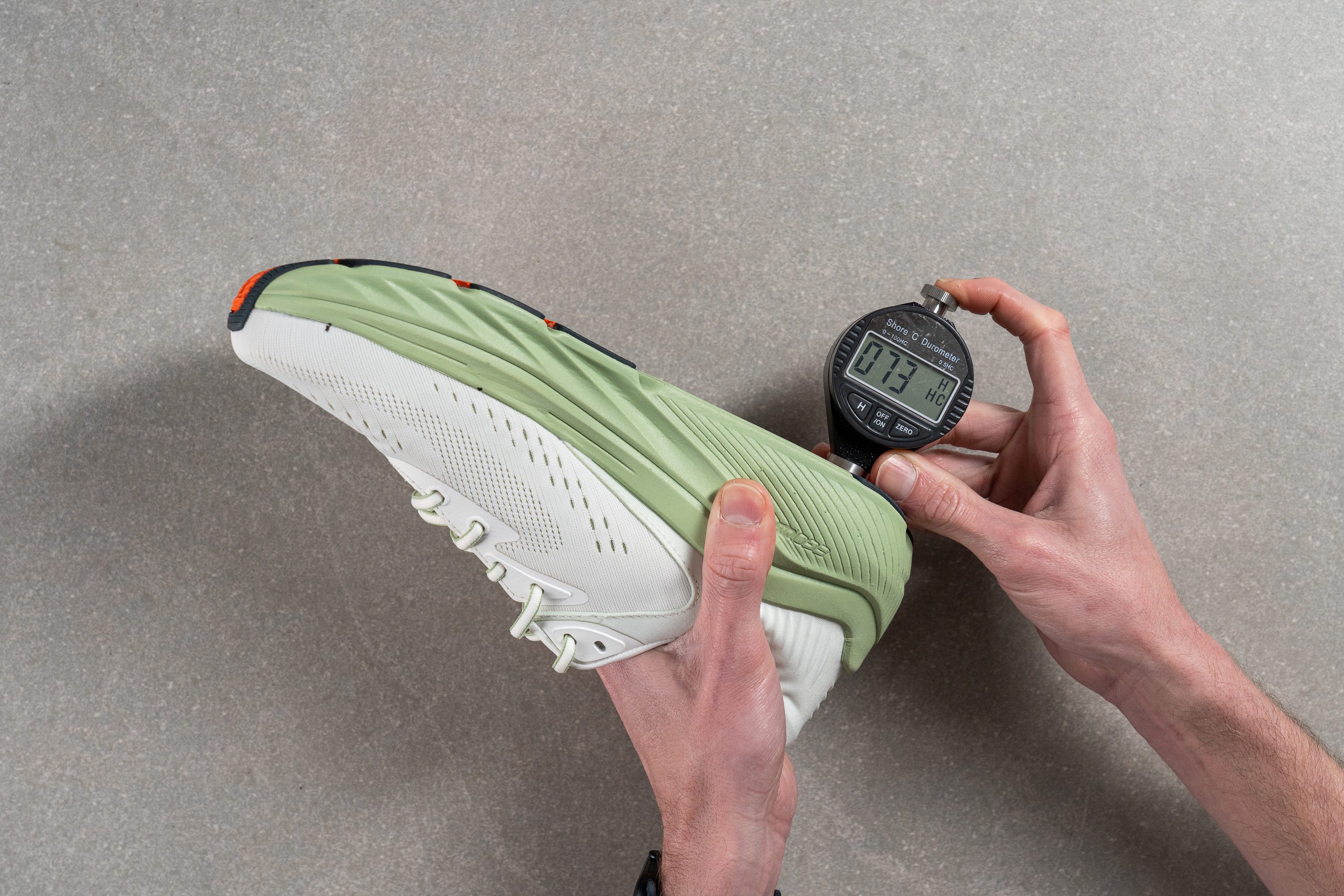
| VIA Olympus 2 | 73.3 HC |
| Average | 79.2 HC |
Outsole durability
So, naturally, we revved up the Dremel once more—this time at double the speed (10K RPM) and for an extended duration.
Astonishingly, the outsole showed merely 0.6mm of wear. While the VIA Olympus 2 comes with a price tag of $165, its durability aspect is absolutely amazing.
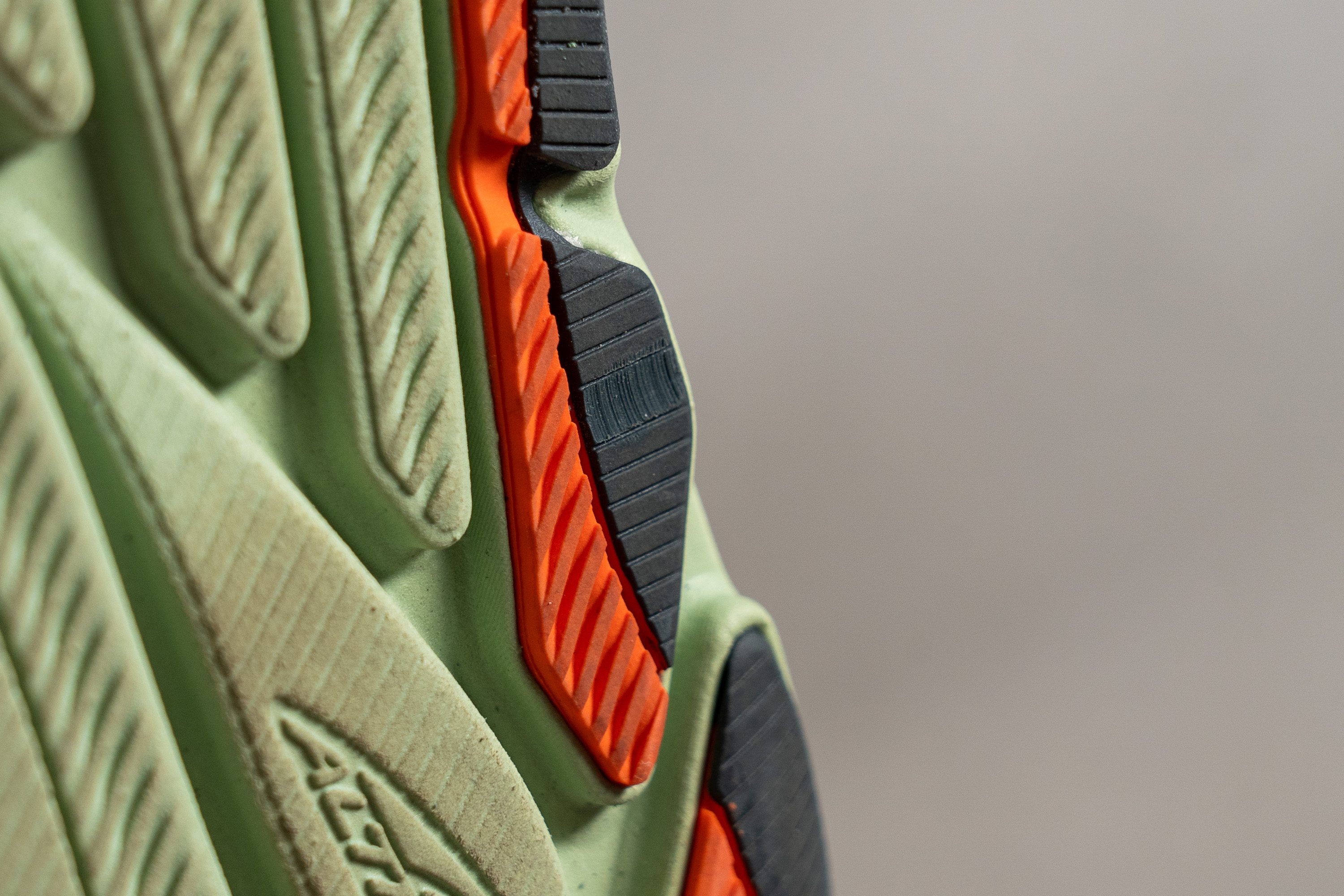
| VIA Olympus 2 | 0.6 mm |
| Average | 1.1 mm |
Outsole thickness
We measured the outsole's thickness at 3.0 mm and, to be honest, we thought it somewhat thick for such a durable rubber.

Slimming down to 2.0mm could not only lighten the load—a welcome adjustment—but also enhance the shoe's feel while running.
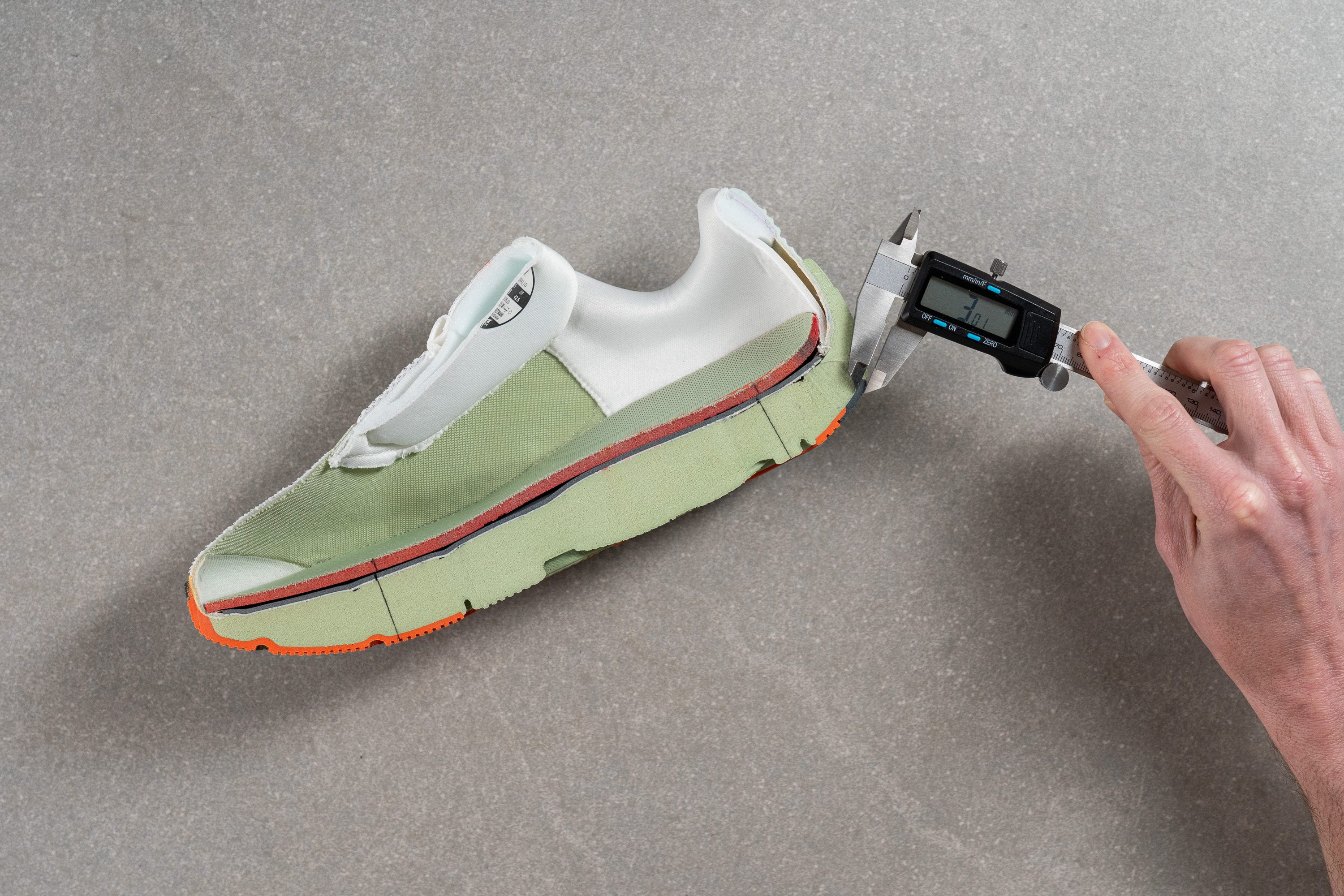
| VIA Olympus 2 | 3.0 mm |
| Average | 3.2 mm |
Misc
Insole thickness
In our test runs, the Ortholite X55 insole delivered exceptional comfort, something we later confirmed in the lab with a precise 5.0-mm measurement.

| VIA Olympus 2 | 5.0 mm |
| Average | 4.5 mm |
Removable insole
We discovered that Altra's footbed isn't glued down, but swapping it out might be trickier than usual due to the toebox's design.
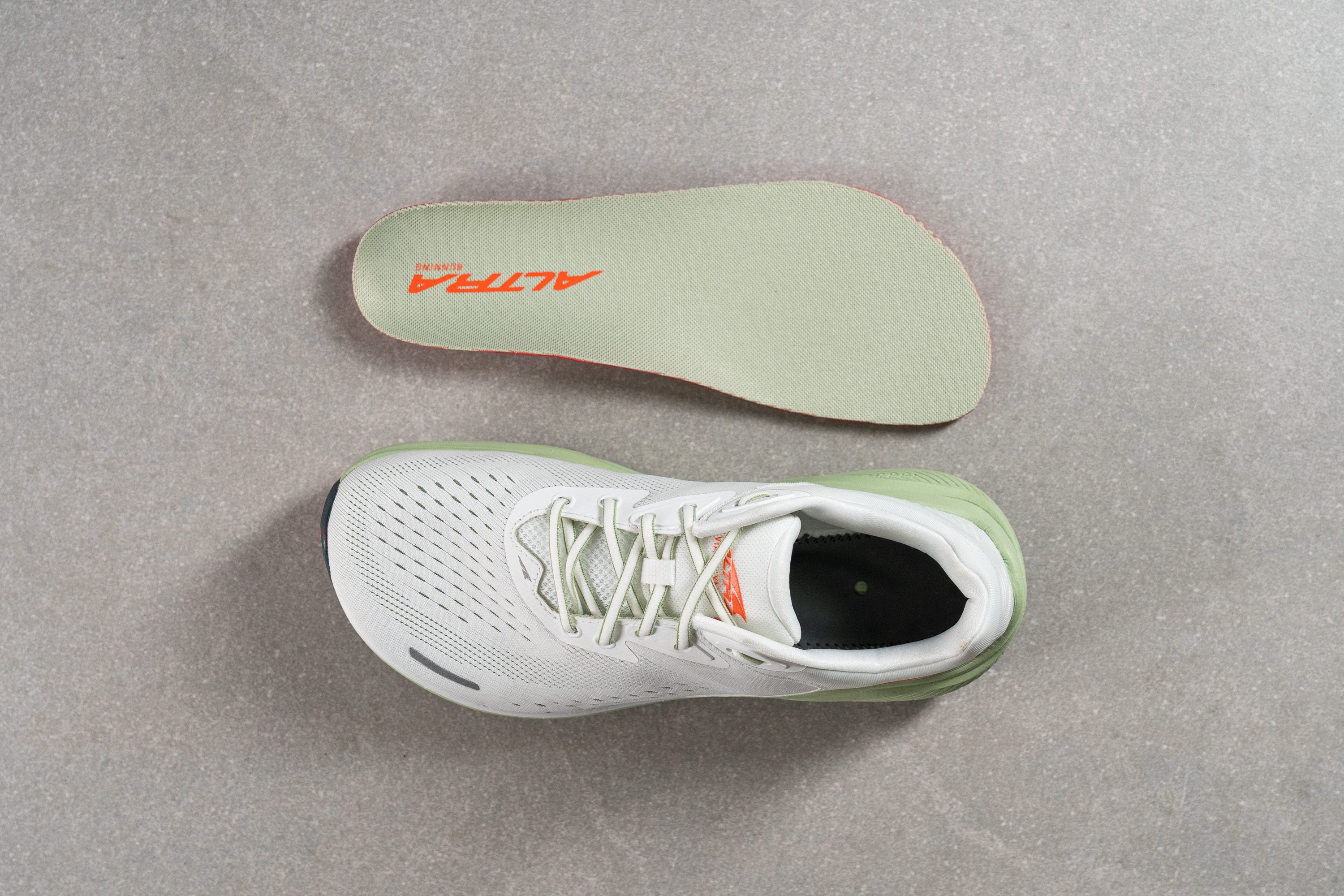
| VIA Olympus 2 | Yes |
Midsole softness in cold (%)
After 20 minutes in our freezer, the EGO MAX foam's firmness increased by just 19.9%—an impressive result for a midsole primarily composed of EVA. This suggests that even in the harshest winter conditions, the change in the foam's feel will be minor.
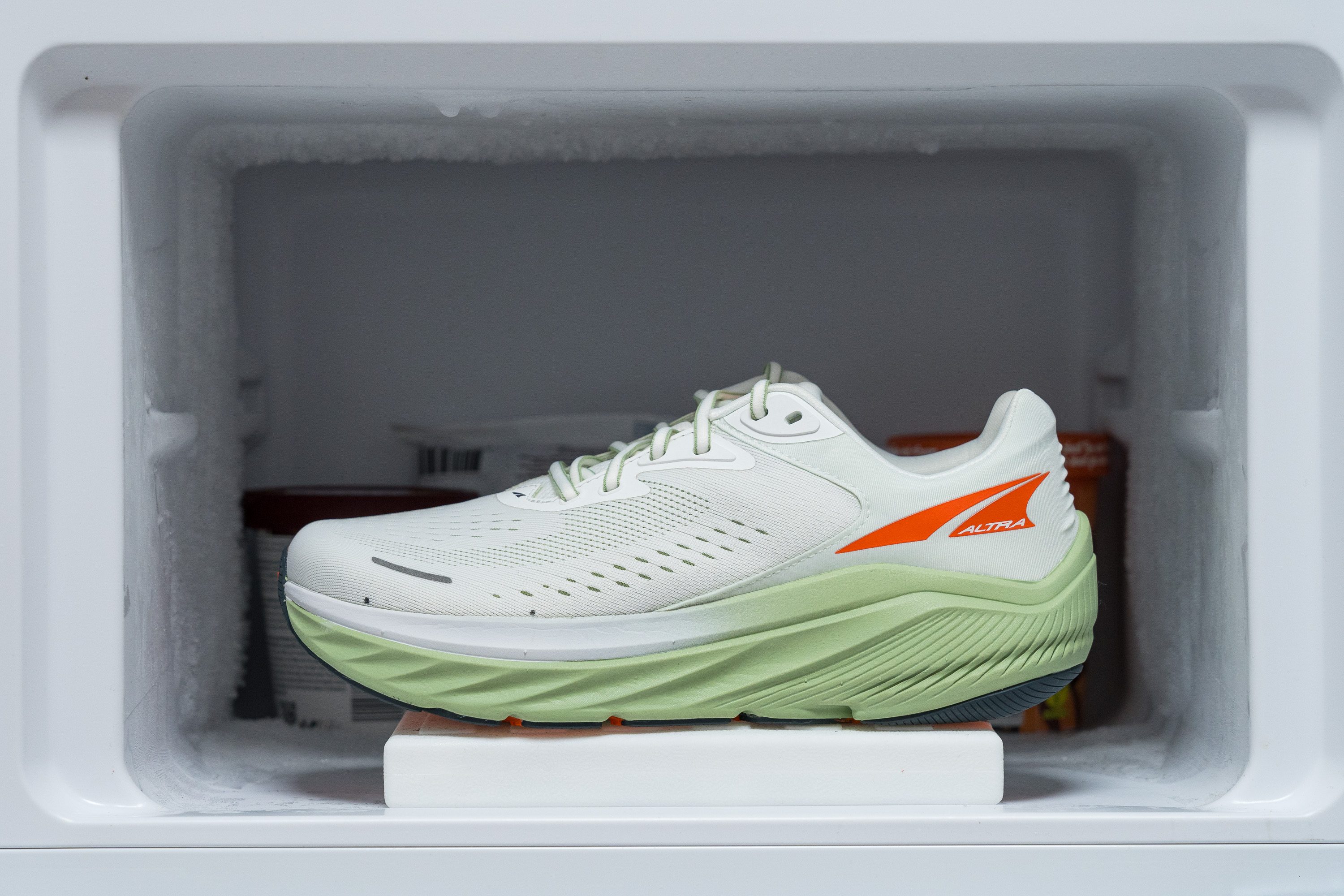
| VIA Olympus 2 | 20% |
| Average | 24% |
Reflective elements
The VIA Olympus 2 lacks reflective elements—a disappointing oversight. We strongly advocate for their inclusion in the next version for enhanced safety during night runs.
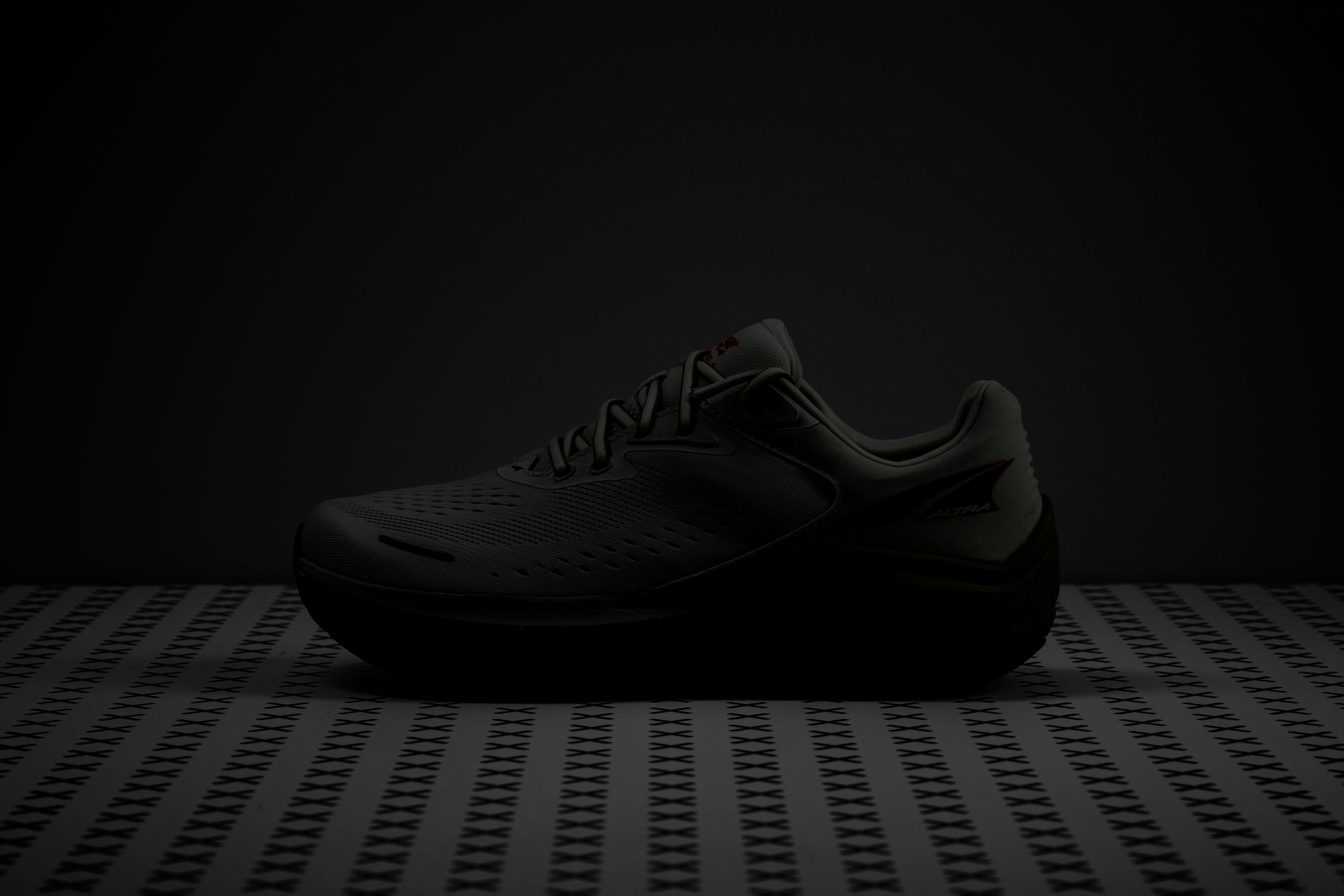
| VIA Olympus 2 | No |
Tongue padding
The tongue of the VIA Olympus 2 hits the perfect sweet spot with its cushioning, measuring 6.1 mm in our test—a slight trim from the previous version's 7.5 mm.

This reduction contributes to a small decrease in weight.
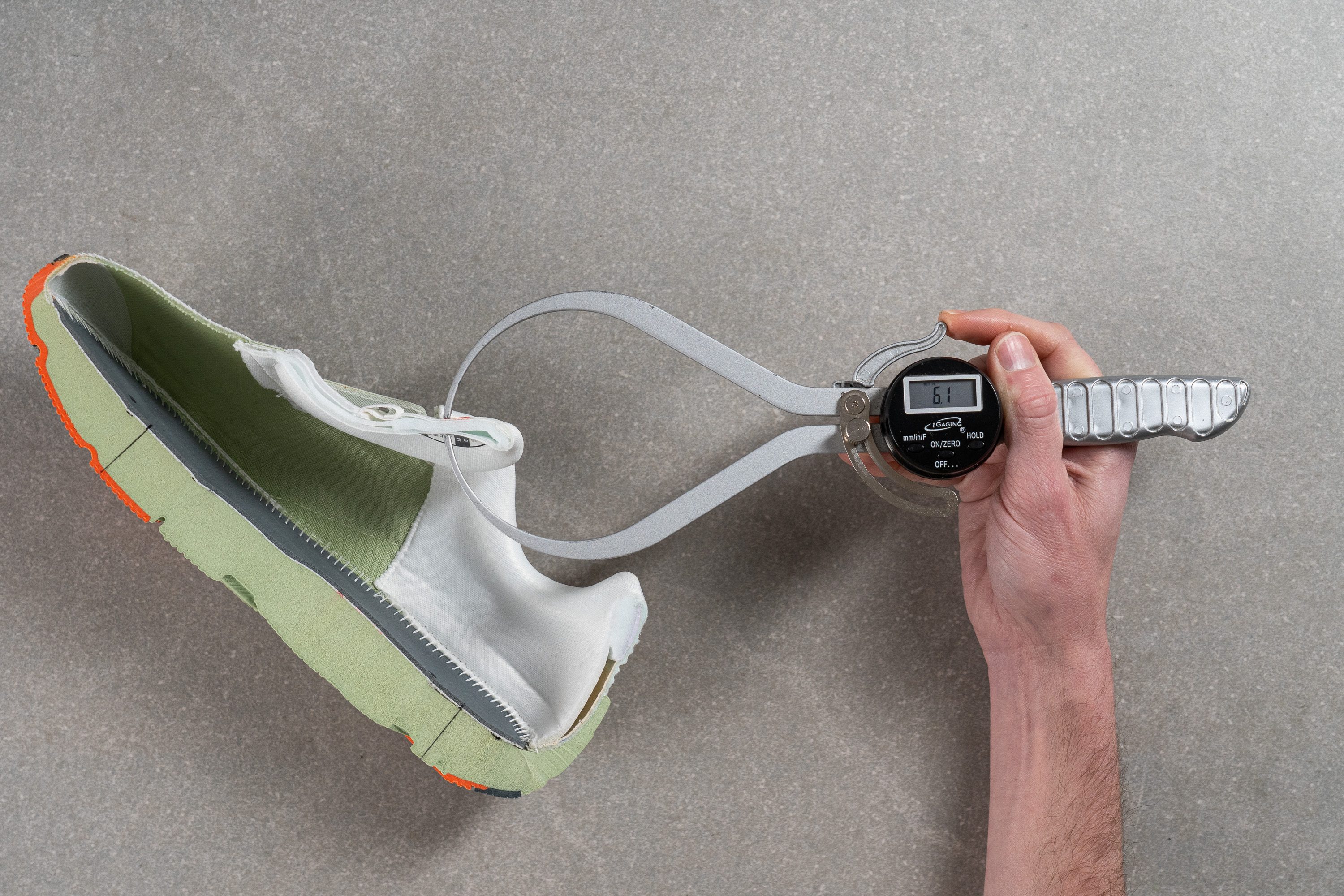
| VIA Olympus 2 | 6.1 mm |
| Average | 5.8 mm |
Tongue: gusset type
Our most significant disappointment with the VIA Olympus 2 is its absence of a gusseted tongue. Despite the first version lacking one and the lockdown being satisfactory, and while getting the same experience with the v2, we believe that a shoe priced at $165 should at least feature a semi-gusseted tongue as a standard offering.
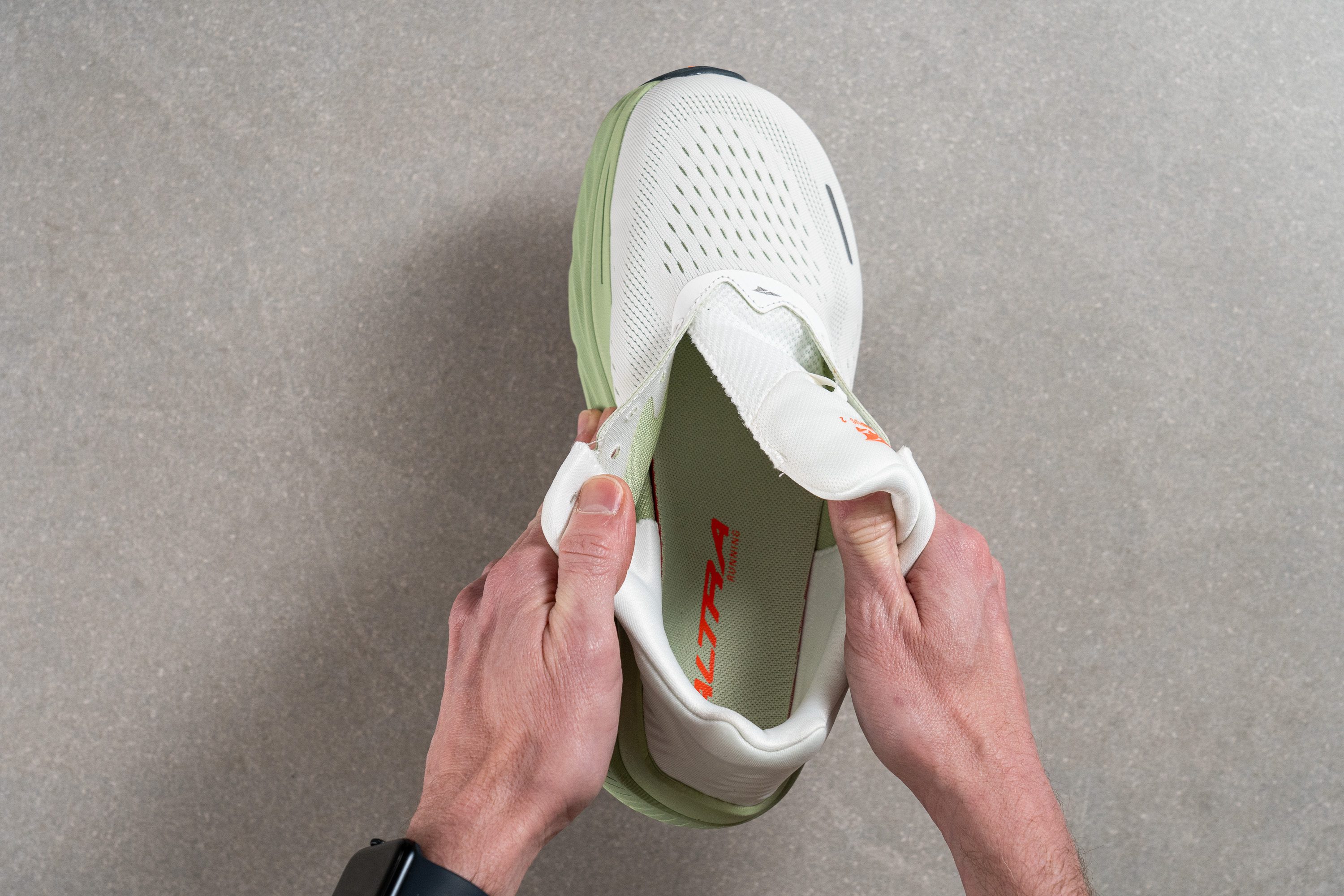
| VIA Olympus 2 | None |
Heel tab
The VIA Olympus 2 maintains a consistent design lineage with its predecessor, which means it also lacks a heel tab.
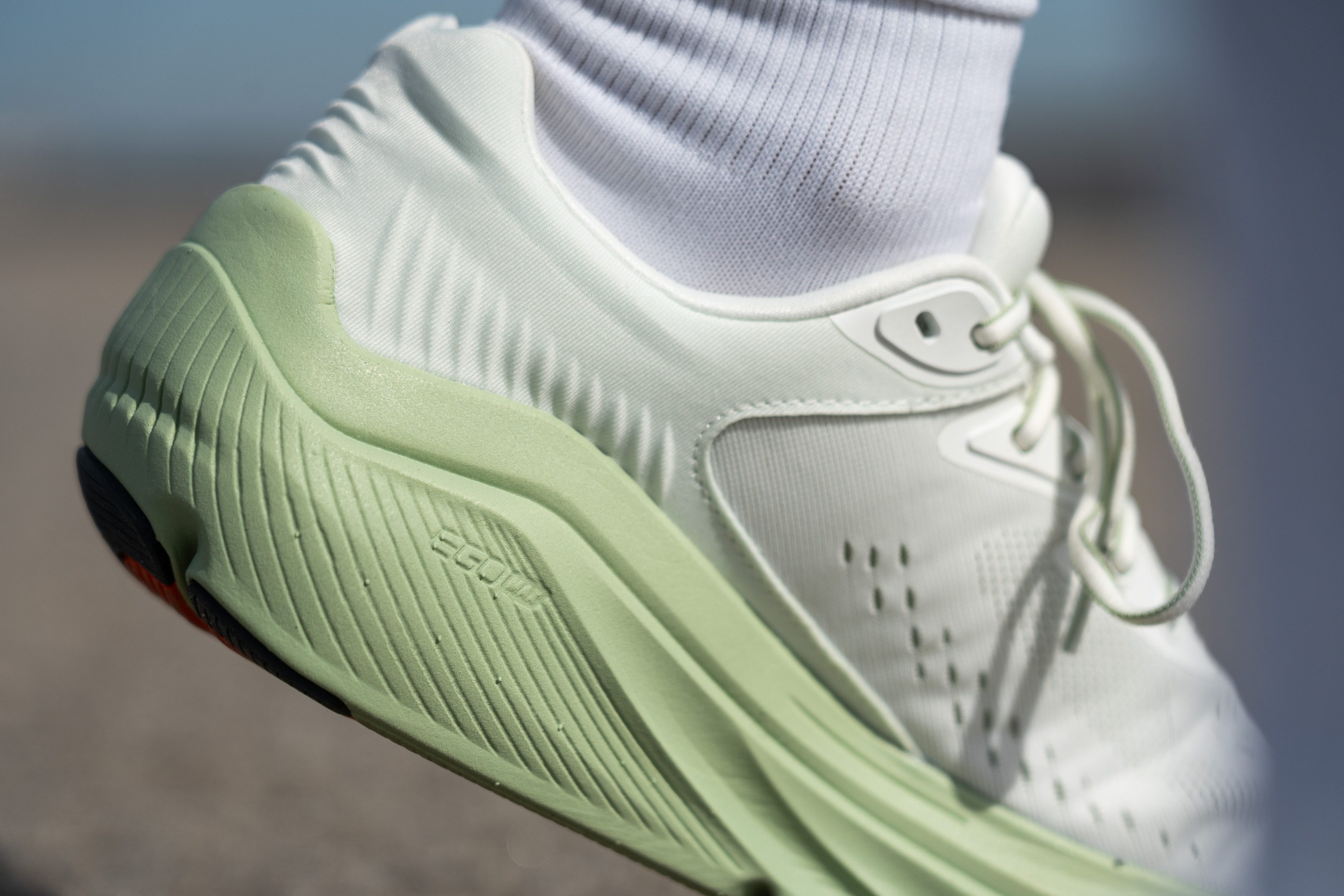
| VIA Olympus 2 | None |

